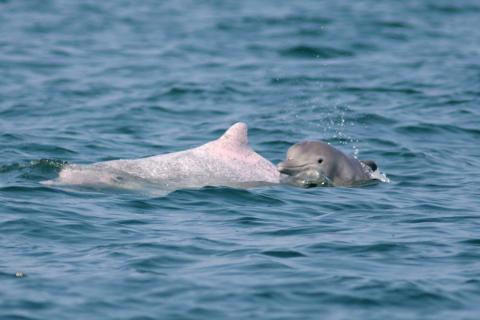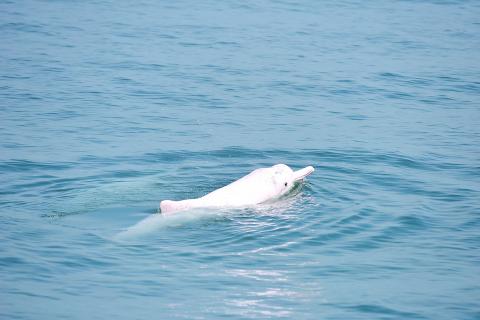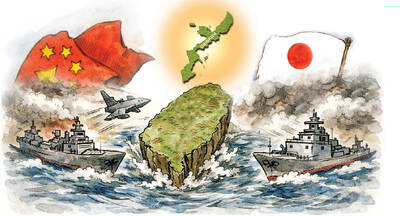Taiwan’s pink dolphins were estimated to number fewer than one hundred when they were listed by the International Union for the Conservation of Nature (IUCN) in 2008 as critically endangered, one step away from extinction. The most recent report from the Council of Agriculture (COA) in January this year suggests the numbers are likely around 50. There is no doubt that the population is in decline, and quite possibly facing extinction two decades after their discovery in 2006.
At a public hearing last week on wildlife conservation, Democratic Progressive Party Legislator Chen Man-li (陳曼麗) and Chinese Nationalist Party (KMT) Legislator Alicia Wang (王育敏) addressed the need for revising Taiwan’s Wildlife Conservation Act (野生動物保育法) to better protect endangered species. The agency in charge of the act, the COA’s Forestry Bureau, agreed to meet with interested parties and come up with draft amendments in time to present to the fall term of Taiwan’s legislature.
My interest is in the conservation of the Taiwanese White Dolphin (Sousa chinensis taiwanensis), Taiwan’s sole endemic cetacean, scientifically discovered in 2002 and on which I have been working for the past 13 years.

Photo courtesy of Yang Si-chu and Matsu’s Fish Conservation Union
In 2006, I was a member of the Environmental Impact Assessment (EIA) Committee, an independent committee under the Environmental Protection Administration that reviews all major development projects, and has legal authority to reject a development proposal if found to be detrimental to the environment.
During a meeting on a steel plant proposed by the Formosa Plastics Group, I was introduced to the Taiwanese White Dolphin. The steel plant, which eventually was relocated to Vietnam, wreaking havoc on that country’s central coastal fisheries, was to accompany construction of the multi-billion New Taiwan dollar KK Petrochemical plant in the relatively remote area of Yunlin County (at the time I was able to find detailed highway maps of every county in Taiwan except Yunlin). Both of these were to have been built alongside Formosa Plastic’s existing massive petrochemical industrial park known as the Sixth Naphtha Cracker or Mailiao Industrial Park.
DOLPHINS VS INDUSTRY

Photo: Jhan Hsiang-wan
Two scientists who discovered the Taiwanese white dolphin testified at the April 2006 steel plant meeting. It was at that point that the tide of unquestioned development in Taiwan began to change. Quite likely, the Taiwanese White Dolphin — they are actually pink when alive, and their Chinese counterparts (Sousa chinensis chinensis) in Hong Kong are known as “the pink dolphins” — was responsible for stopping the KK Project, the Formosa Steel Project as well as a number of proposed power plants and other industrial development along Taiwan’s west coast.
The favored habitat of the pink dolphins, the shallow coastal and estuarine waters within just a few kilometers from the coast running from Tainan to Taoyuan, happens also to be favored by gill net fishers: of the remaining animals a majority of the pink dolphins bear serious scars from nets, and death resulting from entanglement is likely the most serious cause of the population’s decline.
However, and somewhat ironically given the apparent conflict between gillnetters and dolphins, this area is also extremely “favored” by industry as a dumping area for polluted discharge (air and water), land reclamation and other cementification projects, noise and most recently and notably, the NT$100 billion offshore wind farm development. The off shore wind project is touted by the government as one of the most significant industrial projects in Taiwan’s history and has attracted major energy companies, banks and other investors from Europe, Canada, Singapore, Japan and most recently the US. It also has significant local support from government, industry and, because of being “green energy,” the general public.
The irony lies in the fact that the disturbance, pollution and havoc brought to Taiwan’s west coast by unchecked short-term industrial development destroys not only dolphin and other wildlife habitat, but it has also devastated the once incredibly rich fisheries of the eastern Taiwan Strait. When I first began involvement in conservation of Taiwan’s pink dolphin, I thought that dolphin conservationists and fishers would get along famously and gotten together to resist or at least put some checks on industry and its government champions.
But that is where the tragedy plays itself out and we are likely to see a long term lose/lose situation for the dolphins and coastal fishing communities of western Taiwan, whereas the Danish, German and other energy companies, their investors and downstream industries will see a short term boon through their provision of energy that many would argue is showing itself to be less and less green and sustainable.
These developers have taken a clue from the older and established Taiwan petrochemical, construction and power industries and responsible government agencies: buy off the fisher’s associations and let them do your bidding to control the fishers. Then pit the fishers’ associations against the conservationists.
STRONG ARMING
In November 2007, I was present in a meeting where it was obvious that local fishers association officials and politicians were clearly working in the interests of corporate interests and resorted to strong-arm tactics that almost descended into violence.
This conflict illustrates how far the fishers’ association may go when the right people are selected and paid off. And this is the lesson apparently well learned by the offshore wind farm developers and many of the dolphin “researchers” they have hired. It is something the conservationists may have known, but certainly have lacked the resources to develop and follow up on.
In 2006, as soon as we began stating that the gillnets are the major threat to the pink dolphins, we experienced push back from the fishers’ association, but also from the COA, the government agency that supposedly supervises fisheries. The aforementioned government and industry sponsored “researchers” clearly know this, but do not speak out and instead serve as brokers to help the association obtain more benefits and “community give back” from the developers.
There is no doubt a very large portion of the fishing community in Taiwan receives little if any of the benefits conferred by government and industry on “fishers” except through the fishers’ association. The Fisheries Agency admits that the real control of fishers comes from the associations, and while it claims to have some clout over the associations, they rarely use it. Ask anyone who knows anything about political corruption in the less urban areas of Taiwan, such as Changhua and Yunlin, and farmers’, water and fishers’ associations figure prominently.
Fishers are a headache for government and industry, and they need to be paid off and for the most part the easiest way to accomplish this is through the associations. The pink dolphins, or for that matter any endangered species, is also a headache for developers and the government sponsors. After the pink dolphins figured prominently in stopping some of Taiwan’s largest industrial development projects during the first decade of this century, do we think the government is going to let them get in the way this time with the wind farm development? And the fishers’ associations are a great way to keep dolphins and conservationists out of the way.
PROTECTING DOLPHINS
Although a rather provocative title was used for this piece, I don’t believe for a minute that any living person wants to see the Taiwanese White Dolphins go extinct. I do, however, believe that the dolphins are not valued enough when it comes to individual opportunities and may even be deemed expendable by individual researchers, engineers, bankers and government officials.
While this is an unfortunate and sad situation, more to the point, the entities involved — whether it is the government agency overseeing the EIA or industrial development, the banks financing the projects or the companies involved in the myriad development projects such as expansion of the Taichung Port, the LNG facility proposed for Taoyuan alongside the millennia old algal reefs and recently discovered pink dolphin habitat or the offshore wind farm development — those entities are really just machines, programmed to maximize benefits apparently for their shareholders and not their stakeholders (which would include all of us). While sometimes they may emphasize long term benefits such that they may engage in what appears to be socially or environmentally responsible behavior, but in the end, these are not living beings and we should not expect them to do anything other than what they are programmed for.
So, is there a solution? Since the offshore wind farms were first proposed, conservationists have stated that the wind farms do constitute a new threat to the viability of the Taiwanese pink dolphin. But if they could effectively address the other threats, specifically the gill nets, for example through a joint buyout with the government, retraining and subsidizing fishers in other sustainable fishing methods and other environmentally friendly occupations, in other words remove the threat of gill nets, there may be hope for the Taiwanese pink dolphins.
It may be too late, as developers have already made major commitments to fishers’ associations and fishing communities and have likely been persuaded that these measures are sufficient. However, there are still dolphins left, the international scientific community has not given up and scientists are working on a recovery plan. Let’s hope the right people will start listening.
— Robin Winkler (文魯彬), founder of the Wild at Heart Legal Defense Association, Taiwan (台灣蠻野心足生態協會), and chair, Matsu’s Fish Conservation Union (媽祖魚保育聯盟).

Most heroes are remembered for the battles they fought. Taiwan’s Black Bat Squadron is remembered for flying into Chinese airspace 838 times between 1953 and 1967, and for the 148 men whose sacrifice bought the intelligence that kept Taiwan secure. Two-thirds of the squadron died carrying out missions most people wouldn’t learn about for another 40 years. The squadron lost 15 aircraft and 148 crew members over those 14 years, making it the deadliest unit in Taiwan’s military history by casualty rate. They flew at night, often at low altitudes, straight into some of the most heavily defended airspace in Asia.

Beijing’s ironic, abusive tantrums aimed at Japan since Japanese Prime Minister Sanae Takaichi publicly stated that a Taiwan contingency would be an existential crisis for Japan, have revealed for all the world to see that the People’s Republic of China (PRC) lusts after Okinawa. We all owe Takaichi a debt of thanks for getting the PRC to make that public. The PRC and its netizens, taking their cue from the Chinese Communist Party (CCP), are presenting Okinawa by mirroring the claims about Taiwan. Official PRC propaganda organs began to wax lyrical about Okinawa’s “unsettled status” beginning last month. A Global

Taiwan’s democracy is at risk. Be very alarmed. This is not a drill. The current constitutional crisis progressed slowly, then suddenly. Political tensions, partisan hostility and emotions are all running high right when cool heads and calm negotiation are most needed. Oxford defines brinkmanship as: “The art or practice of pursuing a dangerous policy to the limits of safety before stopping, especially in politics.” It says the term comes from a quote from a 1956 Cold War interview with then-American Secretary of State John Foster Dulles, when he said: ‘The ability to get to the verge without getting into the war is

Like much in the world today, theater has experienced major disruptions over the six years since COVID-19. The pandemic, the war in Ukraine and social media have created a new normal of geopolitical and information uncertainty, and the performing arts are not immune to these effects. “Ten years ago people wanted to come to the theater to engage with important issues, but now the Internet allows them to engage with those issues powerfully and immediately,” said Faith Tan, programming director of the Esplanade in Singapore, speaking last week in Japan. “One reaction to unpredictability has been a renewed emphasis on